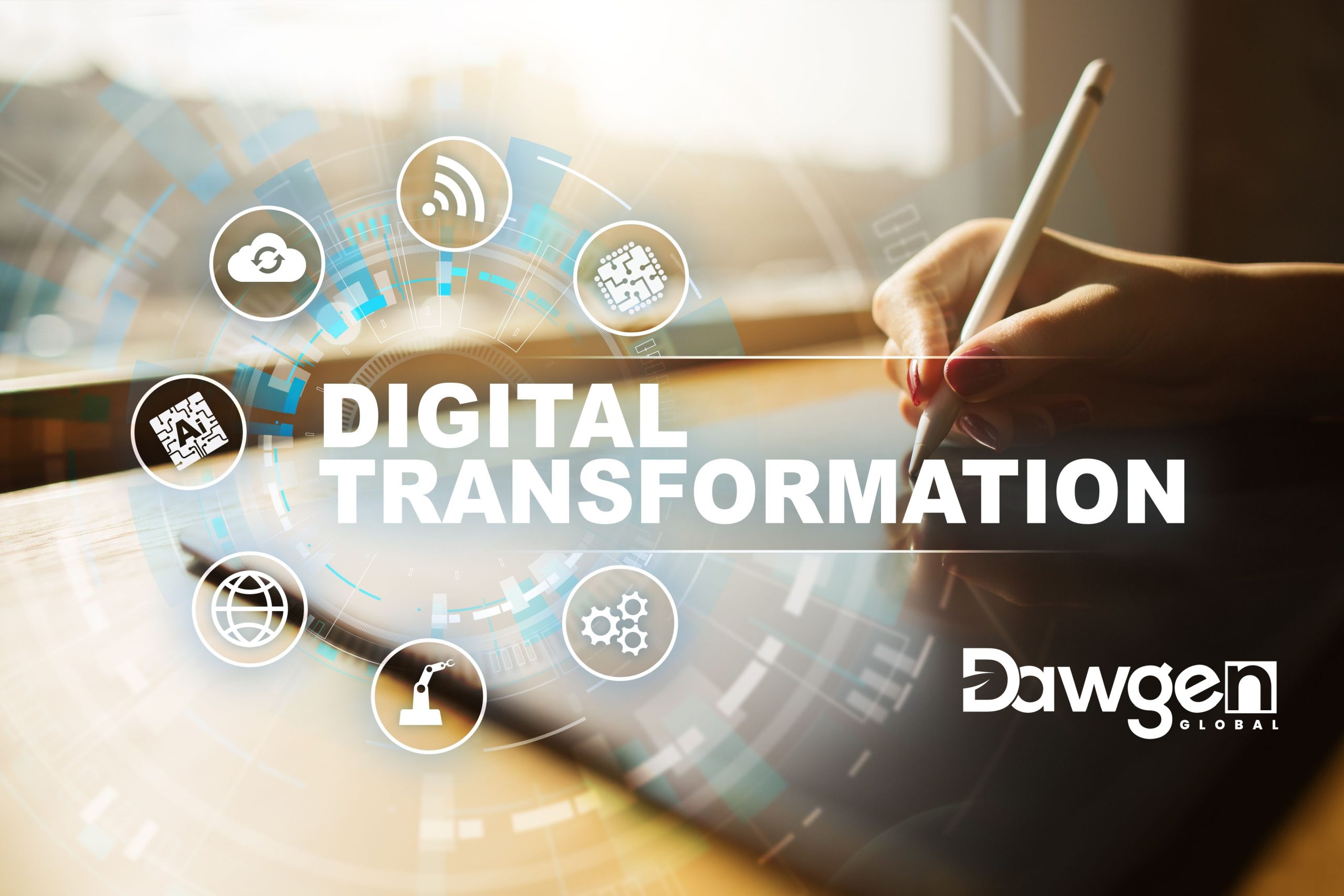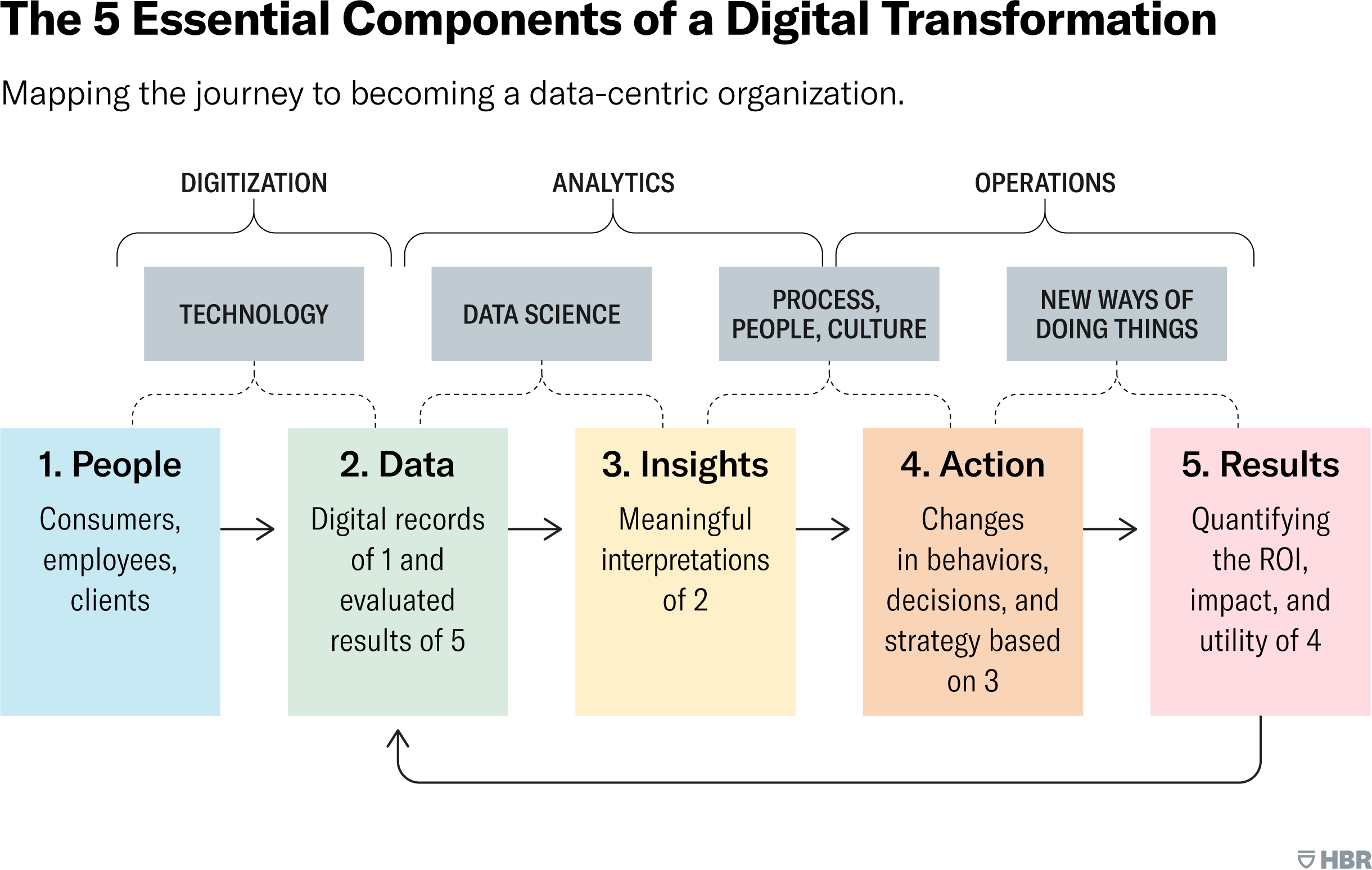 In today’s rapidly evolving business landscape, digital transformation is not just a buzzword—it’s a necessity for organizations aiming to stay competitive and relevant. The journey to becoming a data-centric organization involves several critical components. The framework provided by Harvard Business Review outlines the essential elements of this transformative process, focusing on five key areas: People, Data, Insights, Action, and Results. Let’s explore each of these components in detail.
In today’s rapidly evolving business landscape, digital transformation is not just a buzzword—it’s a necessity for organizations aiming to stay competitive and relevant. The journey to becoming a data-centric organization involves several critical components. The framework provided by Harvard Business Review outlines the essential elements of this transformative process, focusing on five key areas: People, Data, Insights, Action, and Results. Let’s explore each of these components in detail.

1. People
At the heart of any digital transformation are the people—consumers, employees, and clients. Understanding their needs, behaviors, and interactions is crucial. These individuals are the primary sources of data that drive the entire transformation process. By prioritizing the human element, organizations can ensure that their technological advancements are both user-friendly and impactful.
2. Data
The second component is data, which represents the digital records of interactions, behaviors, and outcomes. Collecting and managing data effectively is foundational to a successful digital transformation. This involves not only gathering data but also ensuring its accuracy, accessibility, and security. High-quality data allows organizations to gain a comprehensive view of their operations and customer interactions.
3. Insights
Data alone is not enough. The third component, insights, involves the meaningful interpretation of data. Through analytics and data science, organizations can transform raw data into actionable insights. These insights help identify trends, predict future behaviors, and uncover opportunities for improvement. The ability to generate valuable insights from data is a critical differentiator in the digital age.
4. Action
Insights must lead to action. The fourth component focuses on implementing changes based on the insights gained. This could involve altering business strategies, improving processes, or introducing new products and services. The goal is to drive tangible changes that enhance efficiency, customer satisfaction, and overall business performance. Actions based on data-driven insights are more likely to be effective and impactful.
5. Results
The final component is results. Measuring the impact of actions taken is essential to quantify the return on investment (ROI) and assess the overall success of the digital transformation. This involves evaluating the outcomes and using this feedback to further refine and optimize processes. Continuous measurement and evaluation ensure that the organization remains on the path to sustained improvement and growth.
The Role of Technology, Data Science, and Culture
In addition to the five essential components of digital transformation, three critical elements—technology, data science, and the integration of process, people, and culture—play a foundational role in supporting and enabling these components.
Technology
Technology is the backbone of digital transformation. It facilitates the digitization of data, making it possible to collect, store, and analyze vast amounts of information efficiently. Advanced technologies such as cloud computing, artificial intelligence (AI), machine learning, and the Internet of Things (IoT) enable organizations to harness data in ways that were previously unimaginable.
- Cloud Computing: Offers scalable storage and computing power, allowing organizations to manage large datasets and perform complex analyses without the constraints of physical infrastructure.
- Artificial Intelligence and Machine Learning: Enable automated data processing and predictive analytics, helping organizations to identify patterns and make data-driven decisions rapidly.
- Internet of Things (IoT): Connects physical devices to the digital world, generating real-time data that can be used to optimize operations and enhance customer experiences.
By leveraging these technologies, organizations can streamline operations, reduce costs, and create new opportunities for innovation.
Data Science
Data science is the discipline that transforms raw data into valuable insights. It involves a combination of statistics, mathematics, programming, and domain expertise to extract meaningful information from data.
- Data Collection and Management: Ensures that data is accurately collected, stored, and maintained. Proper data management is crucial for the reliability of any insights derived from the data.
- Analytics and Modeling: Data scientists use various analytical methods and models to explore data, identify trends, and make predictions. This can involve techniques such as regression analysis, clustering, and machine learning algorithms.
- Visualization: Presenting data in a visual format, such as charts and graphs, helps stakeholders understand complex data insights quickly and easily, facilitating better decision-making.
Data science transforms the vast amounts of data generated by modern technologies into actionable insights that drive strategic decision-making and operational improvements.
Process, People, and Culture
While technology and data science are vital, the success of digital transformation ultimately hinges on the people and the organizational culture. Embracing change and fostering a culture of continuous improvement are essential for achieving long-term success.
- Process Optimization: Streamlining and refining business processes to eliminate inefficiencies and improve productivity. This often involves re-engineering workflows and adopting new practices that leverage digital tools.
- People and Skills: Investing in the development of employees’ skills is crucial. Providing training and education on new technologies and data literacy empowers employees to contribute to the digital transformation efforts effectively.
- Culture of Innovation: Encouraging a culture that embraces change and innovation is key. This involves promoting an agile mindset, where experimentation and learning from failures are valued. Leadership plays a crucial role in setting the tone and fostering an environment where innovation can thrive.
By aligning processes, empowering people, and nurturing a culture that supports transformation, organizations can ensure that their digital initiatives are sustainable and impactful.
Conclusion
Embarking on a digital transformation journey requires a holistic approach that integrates people, data, insights, action, and results. Technology provides the tools and capabilities needed to digitize and analyze data, while data science unlocks the insights hidden within that data. However, the true enabler of transformation is a culture that embraces change and innovation, supported by streamlined processes and skilled people.
By following this comprehensive framework, organizations can navigate the complexities of digital transformation and achieve meaningful, lasting change. As businesses continue to adapt to the digital age, these five essential components, supported by technology, data science, and a culture of innovation, will remain the cornerstone of successful transformations.
Next Step!
“Embrace BIG FIRM capabilities without the big firm price at Dawgen Global, your committed partner in carving a pathway to continual progress in the vibrant Caribbean region. Our integrated, multidisciplinary approach is finely tuned to address the unique intricacies and lucrative prospects that the region has to offer. Offering a rich array of services, including audit, accounting, tax, IT, HR, risk management, and more, we facilitate smarter and more effective decisions that set the stage for unprecedented triumphs. Let’s collaborate and craft a future where every decision is a steppingstone to greater success. Reach out to explore a partnership that promises not just growth but a future beaming with opportunities and achievements.
✉️ Email: [email protected] 🌐 Visit: Dawgen Global Website
📞 Caribbean Office: +1876-6655926 / 876-9293670 📲 WhatsApp Global: +1 876 5544445
Join hands with Dawgen Global. Together, let’s venture into a future brimming with opportunities and achievements.

